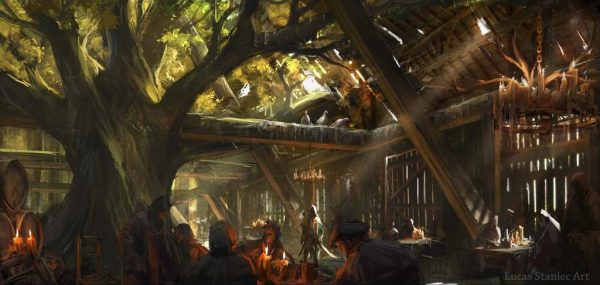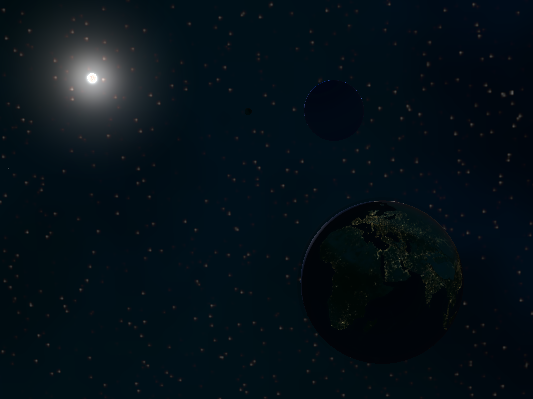 Y’all all don’t what real Gamer ADHD is!
Y’all all don’t what real Gamer ADHD is!
Yesterday I mentioned on Mastodon that I regular keep getting new ideas every few months for what could be really cool campaigns and then losing interest in the work after a few days or weeks, but that it seems like I always keep coming back to the same Sword & Sorcery inspired setting of nature spirits and dinosaurs on an alien forest planet. People asked if there’s any place where they could read more on that world, and there really isn’t anything I could direct people to at this moment. So this post is going to be that.
Kaendor is the current incarnation of a Sword & Sorcery style campaign setting heavily inspired by the worlds of Morrowind and Dark Sun, and the visuals of classic Star Wars and Conan the Barbarian, that I’ve been tinkering and experimenting with since at least back in 2009. I’ve run three separate campaigns in that world over the years, but there have been many drastic overhauls and changes to the geography, history, cultures, and monster populations that it’s become a completely different world from its original incarnation. But looking through my old material, the jumble of ideas and fragments seems to have gained the general shape of what is now the Kaendor setting in Summer 2016 when I wrote my Project Forest Moon concept. Reading it again now, it still feels like a perfect match for what I want to accomplish with the setting.
My previous campaigns were run playing Pathfinder, Astonishing Swordsmen & Sorcerers of Hyperborea, and while I wanted to run D&D Basic/Expert last time, there just wasn’t the audience for it and we ended up playing 5th edition. I had been very seriously considering Barbarians of Lemuria, Worlds Without Number, and Forbidden Lands as systems for future campaigns. But now with the considerable popularity gained by Old-School Essentials, which is reformated reprint of the B/X rules, I think it’s now much easier to get player for it. And it really is the system that Kaendor was always meant to be for.
Inspirations and References
- A Princess of Mars
- Albion (DOS game, 1995)
- Bound by Flame
- Conan the Barbarian
- Dark Sun
- Fire and Ice (by Bakshi and Frazetta)
- Kenshi (PC game, 2018)
- Morrowind
- Nausicaa
- Princess Mononoke
- Record of Lodoss War
- Return of the Jedi
- Severance: Blade of Darkness
- The Empire Strikes Back
- Warcraft III: The Frozen Throne
- X1: The Isle of Dread
- X6: Quagmire!
Yes, this is all very 80s/early 90s. That stuff is on fire! ;)
The Environment
Kaendor is the smaller of a pair of binary planets around an orange dwarf star, the other one being a a blue gas dwarf (a type of planet now known to be common in the universe, but with no example in our solar system). With the stars lower gravitational pull on the planets, a year is slightly longer at 381 days, but with another large planet in place of a moon, months are considerably shorter at only 16 days. (Leading to two 8-days weeks per months.) With the gas planet casting a much larger shadow than a smaller moon, solar eclipses are much more common on Kaendor, and many places see one or two every year, which are typical occasions for many magical rituals.

The surface of Kaendor is about half land and ocean, with almost all but the higher mountain ranges being covered in an endless expanse of trees, giant mushrooms, and swamps. The dominant animals on land are reptiles and insects, with many species growing to enormous sizes. Instead of birds, the skies are home to many kinds of feathered flying reptiles. Mammals are somewhat uncommon, mostly resembling rodents of many shapes and sizes, but there are also many types of deer and goats. (There are no dogs, cats, horses, or bears)
The Peoples
The common Kaendorians are very similar to humans in nature and appearance, but they don’t have any particular resemblance to any specific peoples from Earth. Giants, serpentmen, and fishmen exist, but their numbers are a far cry from what they were tens of thousands of years ago and most people never see even one of them in their entire lives. Insect-like goblins are more common, but they mostly keep to themselves and only occasionally make short visits to other settlements to trade.
Civilization on Kaendor is generally fairly small. While there are many large river valleys for civilizations to arise, there are few open plains, and clearing the ancient forests along the river banks is difficult and dangerous work with the massive scale of many old trees and the amounts of deadly animals and treacherous spirits. A few major cities exist near the coast, but mostly people live in small towns and surrounding villages scattered far and wide across the lands, in whatever small patches of farmable land can be found. The larger city states can establish some kind of centralized government over the surrounding towns and villages a few days’ ride out from their city walls, but most people are ruled over by local chiefs or tribal councils.
The technology level of Kaendor is mostly Bronze Age, with crudely made iron being only suitable for nails, cooking pots, arrowheads, and armor scales, but too fragile for weapons, tools, or chainmail. There are a few roads through the forests connecting the city states with nearby towns, but transportation of heavy goods is done almost entirely by boats over longer distances, or hauled by pack animals that can walk on narrow trails and step over roots or through mud. Wheels are only used for wheelbarrows or handcarts within towns and villages.
The Supernatural
This is an aspect of the setting that is still somewhat up in the air and I am currently undecided on how I want to nail down the specific rules for the future. In general term, all the natural forces in the environment are the actions of spirits. Most spirits of plants and stones are extremely simple beings that have no real consciousness, personality, or individual traits. They simply exist, maintaining the natural cycles of the environment through their passive influence. But the spirits of particularly ancient trees or large caves, and especially the spirits of whole forests, mountains, or island are very powerful entities that have a great awareness of everything that happens within their domains and the power to influence the environment directly to their will. However, the nature of these great spirits is completely different from that of mortals, and they perceive the world and understand events in drastically different terms. Their desires and choices lie well outside the comprehension of ordinary mortal minds and they generally have no concerns of any kind how their actions and changes to the environment affect individual people or even whole villages.
All settlements require a shaman who knows the local spirits and has at least a basic understanding of their goals and desires. The role of the shamans is to consult with the spirits to get permission to build new settlements or make any major changes to the environment and to plead with them for understanding about offenses or aid in times of hardship. They also perform the many rituals and sacrifices demanded by the spirits in return for their continued permission to settle, farm, hunt, and mine in their domains. The exact purpose of many rituals and what the spirits actually gain from them is a mystery even to many shamans, but they are not questioned as subservience to the spirits is an everyday part of life everywhere on Kaendor.
Magic that falls outside the domain of interactions with the spirits exists in the realm of sorcery and is closely tied to demons. Being part of the environment and regulating its natural processes, the power of the spirits is limited to guiding the many forces of nature, but it can not break its laws. It can control plants and the weather, accelerate healing or cause disease, or increase strength or cloud the minds of mortal creatures. Existing outside of nature and coming directly from the primordial chaos, demons are not bound to such limitations. Sorcery can do the impossible by rewriting the laws of nature and overturn the natural order, making it potentially extremely powerful. However, the natural world is extremely complex with everything influencing and affecting everything else, and seemingly minor changes that disrupt the natural order can have impossible to predict consequences with wide reaching scale. Sorcery is inherently corrupting, spreading decay and sickness in everything it touches. The effects of a single spell are typically very subtle, and over time the natural order will restore itself and the damage disappear. But the continuous use of demonic chaos magic has devastating effects on both sorcerers and the lairs in which they perform their spells and rituals. The transformation into ghouls is the first stage of the effects of continuous exposure to sorcerous spells or corrupted environment. At that point there is rarely any hope for victims of returning to their former selves, and the only paths ahead if the effects of sorcery persists are numerous forms of true undeath.

Very evocative work. I also have a fondness for the Bronze Age and Sword & Sorcery so I’m always interested to read more about your work.